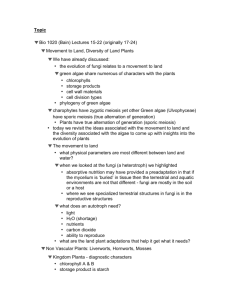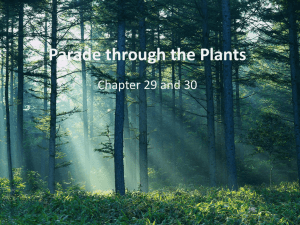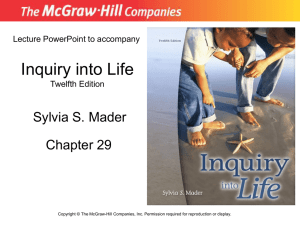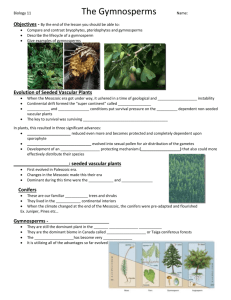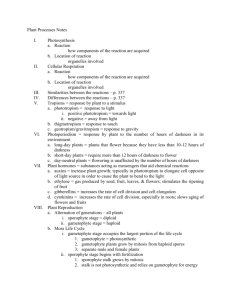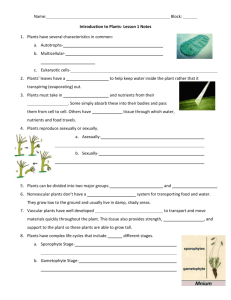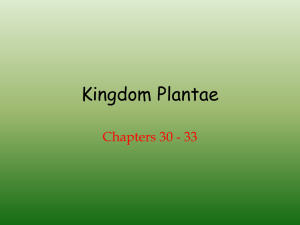Lectures 8-15 (word format)
advertisement
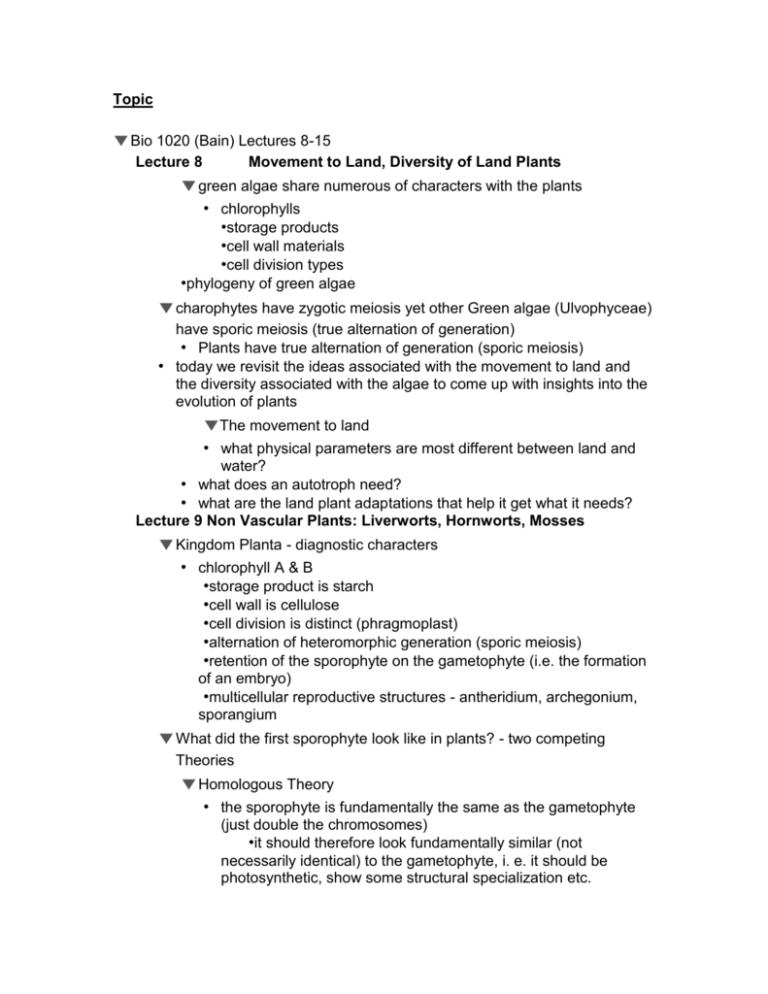
Topic ▼ Bio 1020 (Bain) Lectures 8-15 Lecture 8 Movement to Land, Diversity of Land Plants ▼ green algae share numerous of characters with the plants • chlorophylls •storage products •cell wall materials •cell division types •phylogeny of green algae ▼ charophytes have zygotic meiosis yet other Green algae (Ulvophyceae) have sporic meiosis (true alternation of generation) • Plants have true alternation of generation (sporic meiosis) • today we revisit the ideas associated with the movement to land and the diversity associated with the algae to come up with insights into the evolution of plants ▼The movement to land • what physical parameters are most different between land and water? • what does an autotroph need? • what are the land plant adaptations that help it get what it needs? Lecture 9 Non Vascular Plants: Liverworts, Hornworts, Mosses ▼ Kingdom Planta - diagnostic characters • chlorophyll A & B •storage product is starch •cell wall is cellulose •cell division is distinct (phragmoplast) •alternation of heteromorphic generation (sporic meiosis) •retention of the sporophyte on the gametophyte (i.e. the formation of an embryo) •multicellular reproductive structures - antheridium, archegonium, sporangium ▼ What did the first sporophyte look like in plants? - two competing Theories ▼ Homologous Theory • the sporophyte is fundamentally the same as the gametophyte (just double the chromosomes) •it should therefore look fundamentally similar (not necessarily identical) to the gametophyte, i. e. it should be photosynthetic, show some structural specialization etc. ▼ Antithetic Theory •the sporophyte is a ‘unique’ structure that evolved in response to selection pressure for greater spore production •therefore the first sporophyte should be a spore producing structure, i.e. not specialized for photosynthesis or anything else, just spore production ▼ ‘Bryophytes’ - are structurally simple plants that we believe resemble the first plants • small and inconspicuous •no vascular tissue (no xylem or phloem) •no true stems, roots or leaves (because they have no conducting tissues) •gametophyte is dominant; sporophyte is reduced and not truly free living (retained on the gametophyte throughout its lifetime) •antheridia and archegonia are multicellular structures •flagellate sperm cells require water for fertilization ▼ 3 phyla ▼ Hepatophyta (9000 species) • prostrate or dorsiventrally flattened •leafy and thallose •rhizoids on the undersurface for absorption •pores on the surface open into air chambers where PHS occurs ▼thallose (e.g. Marchantia) • lobed or broad and ribbon-like •rhizoids anchor ▼reproduction • archegonium and antheridium develop on stalks above the thallus •flagellate sperm are raindrop dispersed •embryo develops in archegonium •vegetative reproduction by fragmentation or gemmae ▼ ‘Leafy’ liverworts • look like mosses but are generally prostrate ▼ Anthocerophyta (6 genera; 100 species) • gametophyte - small, flat, lobed and circular •sporophyte cylindrical, spike-like, relatively large and photosynthetic ▼ Bryophyta (15000 species) • protonema -filamentous or platelike photosynthetic structure that emerges from the spore • gametophore - the stalk or visible portion of the gametophyte that germinates from the protonema •true mosses (know life cycle - Fig. 29.8) •Sphagnum - Peat mosses Lecture 10 Vascular Plant Structure ▼ Vascular Plants are a monophyletic group ▼ they have a dominant, branched sporophyte • as the sporophyte continues to evolve into a larger, more complex structure (maybe in response to competition for light, maybe to better disperse spores, maybe both) it gets further away from its source of water (and the bottom of the plant gets further from the light - so the evolution of a specialized tissue to transport water to the extremities and sugars (from PHS) to the buried portions ▼ they have true vascular tissue (xylem and phloem) • the xylem has lignin in the secondary cell wall ▼ True vascular tissue implies a level of tissue differentiation ▼ three fundamental cell types in vascular plants ▼ primary wall only - parenchyma and collenchyma • metabolism and support ▼ secondary wall containing lignin - sclerenchyma • support (and transport) and protection ▼ three fundamental tissue regions - epidermis, ground tissue, vascular tissue • epidermis - protection and transfer (light, CO2, H2O) •ground tissue - metabolism, storage •vascular tissue - transport and support ▼ the development of cell types and tissue regions radiates from localized regions of growth and development called meristems primary and secondary meristems ▼ primary are present in the embryo • apical - at the tips of the shoots (including branches) and roots ▼ secondary - develop later in the plant’s life • responsible for increases in girth - e.g. cambium produces wood ▼ A closer look at vascular tissue • xylem • phloem ▼ A closer look at the epidermis •the covering (cuticle) covers most of the aerial portions •the pores we described with respect to the first PHS organisms are now more complex - they now can open and close and are called stomata (stoma singular) •epidermal cells are generally transparent to let light through •epidermal cells in the root (root hairs) increase surface area to improve absorption ▼ development of organs ▼ shoot • both branches and leaves originate in the apical meristem • both originate on the surface (superficial origin) ▼ roots • subapical meristem (under the root cap) - protection of growing points • branches have an endogenous origin (not superficial like in stems) Lecture 11 Seedless Vascular Plants ▼ development of organs ▼ leaves have two separate origins • microphylls arose via vacularization of an unvascularized ‘flap’ of tissue • megaphylls arose from the flattening and webbing in of a branching axis ▼ reproduction • sporophyte may increase in size to better disperse spores •conversely gametophyte may be restricted by gametes need for H2O • gametophyte may also be restricted by the success of the sporophyte - the lareg sporophyte obliterates the gametophyte anyway, so perhaps it is better to have little in the way of tissue etc. invested in the gametophyte • archegonia and antheridia are similar to those in bryophytes • gametophytes may be hermaphroditic (homospory) or unisexual (heterospory - microspores and megaspores) ▼ the first vascular plants • fossil evidence goes back about 450 million years • the oldest plants we know about are vascular plants - but they are unlikely to have been the first plants • predictably they are very simple organisms ▼there are two main groups •one with terminal sporangia •one with lateral sporangia and flaps of tissue (non vascularized) ▼ extant vascular cryptogams - 2 divisions (phyla) ▼ Lycophyta (club mosses) • leaves are microphylls - arose from vascularized flaps (enations) •sporangia are lateral, associated with leaves and often aggregated into cones (that are terminal) •Lycopodium, Selaginella, Isoetes are extant ▼ Pteridophyta (ferns and horsetails) ▶ Horsetails or scouring rushes - Equisetum is the only extant genus ▶ Ferns •Psilotum looks like an ancient vascular plant, but is now thought to be a fern relative • know the fern life cycle (Fig. 29.12) Lecture 12 Origin of Seeds • the seed •a structure formed by the maturation of the ovule of seed plants following fertilization •a multicellular structure containing the embryo of a higher plant, typically with stored food, the whole protected by a seed coat •the part of a flowering plant that contains the embryo and will develop into a new plant if sown; a fertilized and mature ovule. •zygote retention is characteristic of land plants •as sporophyte becomes dominant, gametophyte remains relatively fragile ▼ dispersal may be limited by available sites for the gametophyte • retention of gametophyte on sporophyte would provide an assured available site with a suitable environment •gametophyte would then develop inside sporangium •advantages •disadvantages ▼ how is fertilization accomplished in an aerial environment? • the ovule is an integumented megasporangium •the seed is a fertilized ovule •seed versus spore Lecture 13 Gymnosperms ▼ seed plants - diagnostic characters • heterospory - unisexual gametophytes •megaphyllous •terminal sporangia ▼all are eustelic (extant) ▼ eustele is a vascular system with the xylem and phloem in discrete bundles, often in a ring. • the pattern may have evolved as a more efficient way of gaining vertical support for the same investment in xylem (secondary wall) ▼ interfacial cambium - secondary meristem (Fig. 35.18, 35.19, 35.20) ▼ cambium • develops between xylem and phloem • produces xylem to inside and phloem to outside ▼ bark • replaces epidermis in secondary growth situations ▼ 5 Divisions (phyla) of seed plants; four gymnosperms (paraphyletic) and one angiosperm ▼ Cycadophyta - Cycads (numerous genera) • palm-like leaves •barrel-like unbranched trunk •sub-tropical or tropical •common during the age of the dinosaurs ▼ Ginkgophyta - Ginkgo biloba • only one species in the division/phylum •Maidenhair tree •broad deciduous leaves •resistant to air pollution so it is commonly planted in cities •also dioecious -females seed coat smells as it rots so seldom planted ▼ Gnetophyta - Gnetum, Ephedra, Welwitschia • three very distinctive genera from different parts of the world •ephedrine (ma huang) is a heart stimulant (and decongestant) that raises blood pressure ▼ Coniferophyta - conifers (pines, spruces, firs, douglas firs, larch, cedar, hemlocks, junipers) - know Life cycle Fig. 30.6 • woody and evergreen (mostly) •pines, spruce, firs, larches, Douglas firs, cedars, junipers etc. ▼cone structures ▼ male cone (simple structure - just leaves) • microsporophyll with microsporangia on underside ▼ female cone -bract scale complex (compound structure) • bract = leaf •scale = branch •ovule on branch • oldest organism -P. longaeva - bristlecone pine -4900 years old • tallest -redwood -113 metres • Anthophyta - angiosperms (flowering plants) Lecture 14 Angiosperms (know Life cycle - Fig. 30.10) ▼ there are numerous differences between angiosperms and gymnosperms • seeds are contained in an ovary (derived from a leaf) ▼ reproductive structures are usually bi-sexual (flowers) composed of modified leaves • calyx (sepals), corolla (petals), androecium (stamens; made up of anther (microsporangium) and filament), gynoecium (pistils made up of stigma, style, ovary) ▼ pistils (ovaries) mature into the fruit • ovules mature into seeds as in gymnosperms ▼ gametophytes are very reduced • the male gametophyte is 2-3 cells ▼ the female gametophyte is only 7-8 cells • therefore it can provide no nourishment for the developing embryo ▼ sex involves double fertilization (pg. 599-600) • the second sperm fuses with two gametophyte cells • storage tissue is the product of fertilization too endosperm ▼ vascular tissue differences • vessel members (conduction) and fibres (support) are specialized angiosperm xylem cells that have evolved from the more generalized xylem cells (tracheids) found in gymnosperms • compare the weight of wood ▼ lots of variation within the division ▼ stem (variations from text) • rhizome • stolons • tubers • succulents • photosynthetic ▼ Leaf • distinct origin in the apical meristem ▼ External Parts • petiole (stalk); blade ▼ simple vs. compound • relate to presence of axial bract ▼ Classes - monocots and dicots • leaves with parallel venation (monocots) vs. net venation (dicots) • floral parts in 3’s (monocots) vs 4s and 5s (dicots) ▼ the coevolution with animals has been a critical factor in the evolution of angiosperms ▼ dispersal • seeds/fruits and pollen ▼ Fruits • mature ovary wall • adapted for attraction (biotic dispersal), protection, dispersal ▼ abiotic dispersal • Wind adaptations of fruits (and seeds) • water • some explosive mechanisms • biotic dispersal Lecture 15 and pollen Angiosperm Diversity & Coevolution - disperal of seeds ▼ Seed/Fruit dispersal syndromes • the dispersal of the seed to an appropriate habitat is the ultimate goal • the dispersal of the fruit sometimes helps seed dispersal • ▼ Abiotic versus Biotic within Biotic ▼ those that involve attraction/reward • the reward has to be something other than the seed • it is usually sugar, sometimes oil ▼ those that are passively "hitchhiking" • burrs and hooks etc ▼ Floral/Pollination syndromes ▼ the big difference between pollen and seed is that pollen has a very precise destination • pollen is seldom packaged in the same way as seeds are - it is usually "naked" ▼ Abiotic and biotic disperal of pollen • Abiotic is almost always wind/but some examples of water ▼ Biotic • trends towards specialization (from wind to animal, but within animal groups too) ▼ most involve attraction/reward • the attraction is colour, shape, scent • the reward is nectar or pollen • mechanisms for deposition of pollen on the animal (vector) and in specific spots (where the stigma on the next flower can pick it up)

